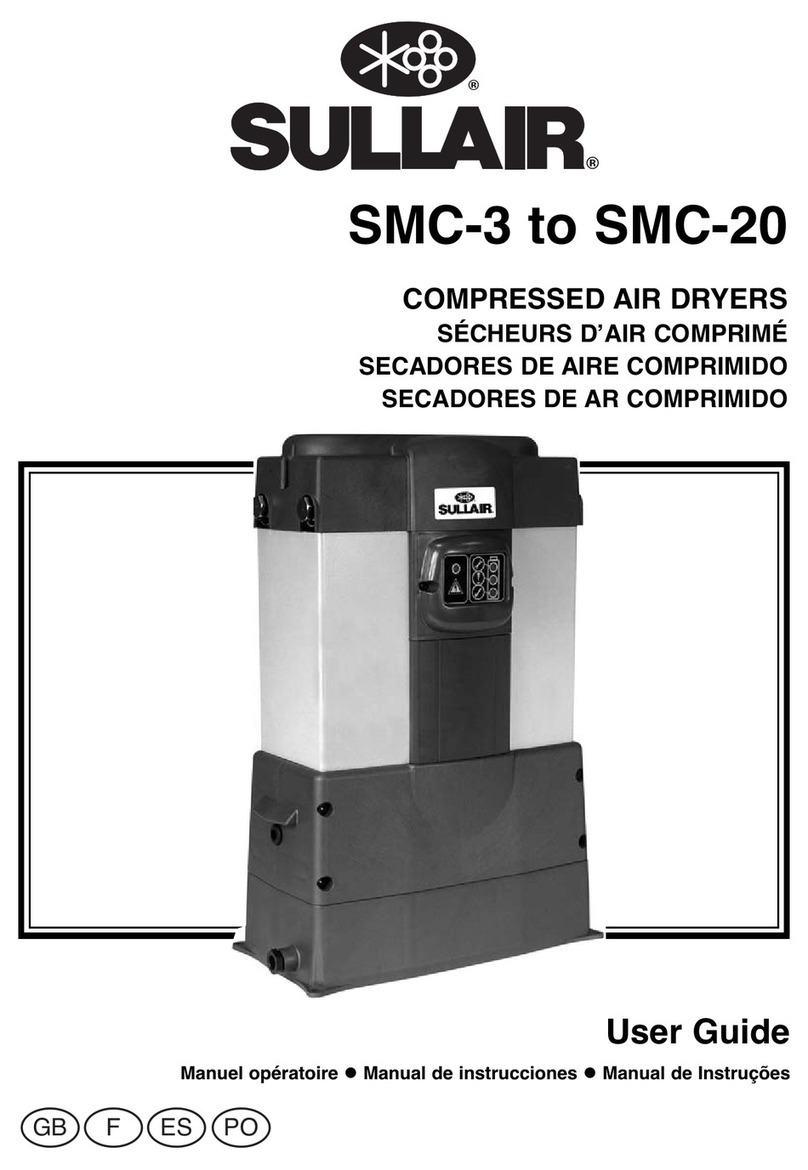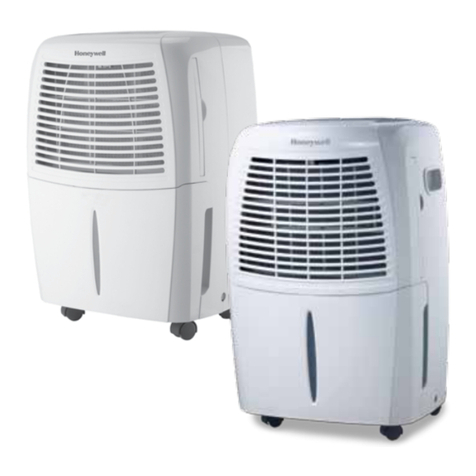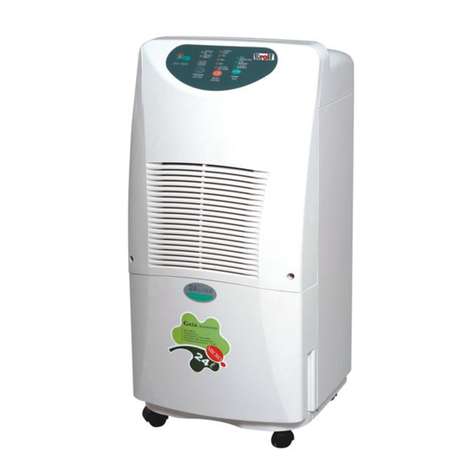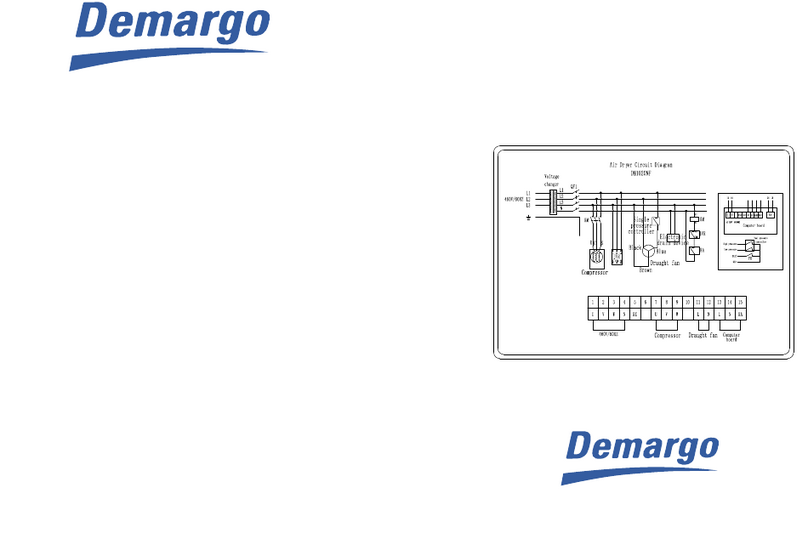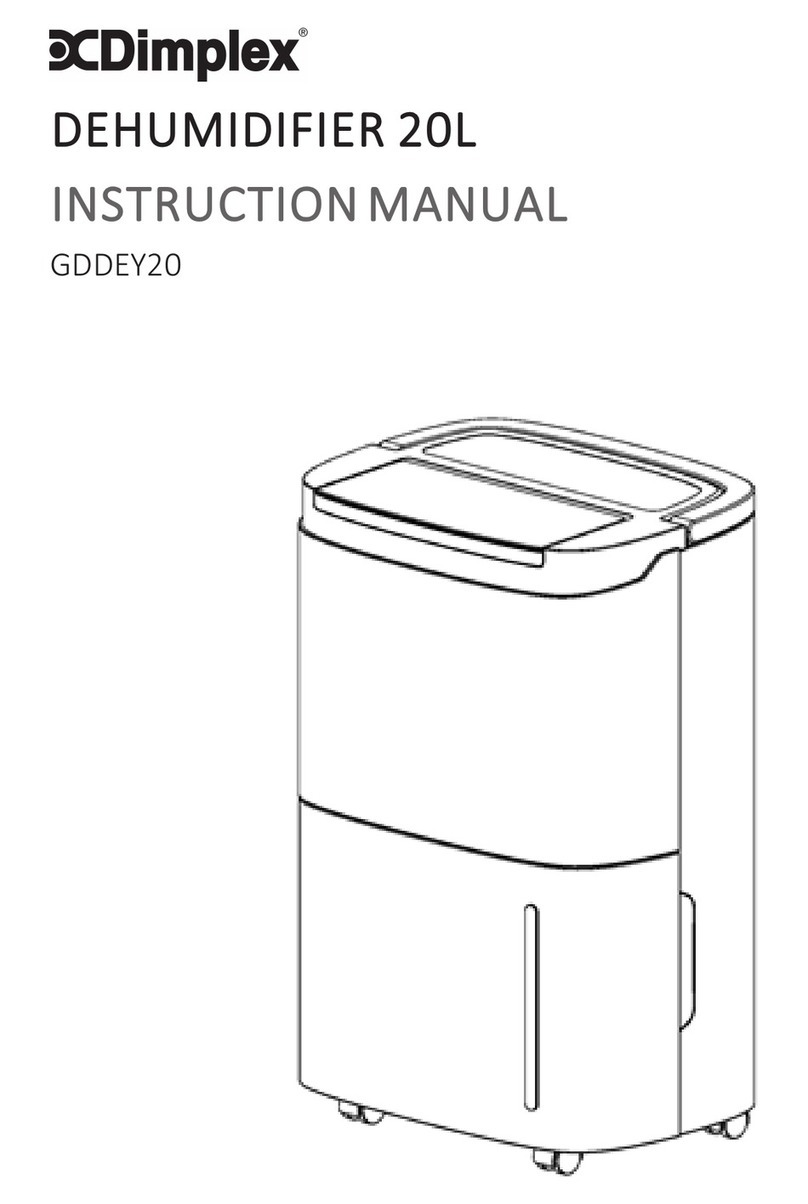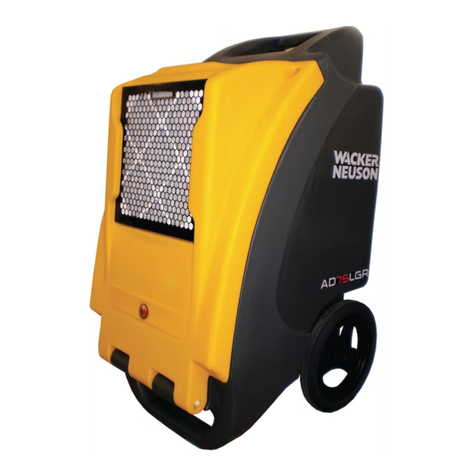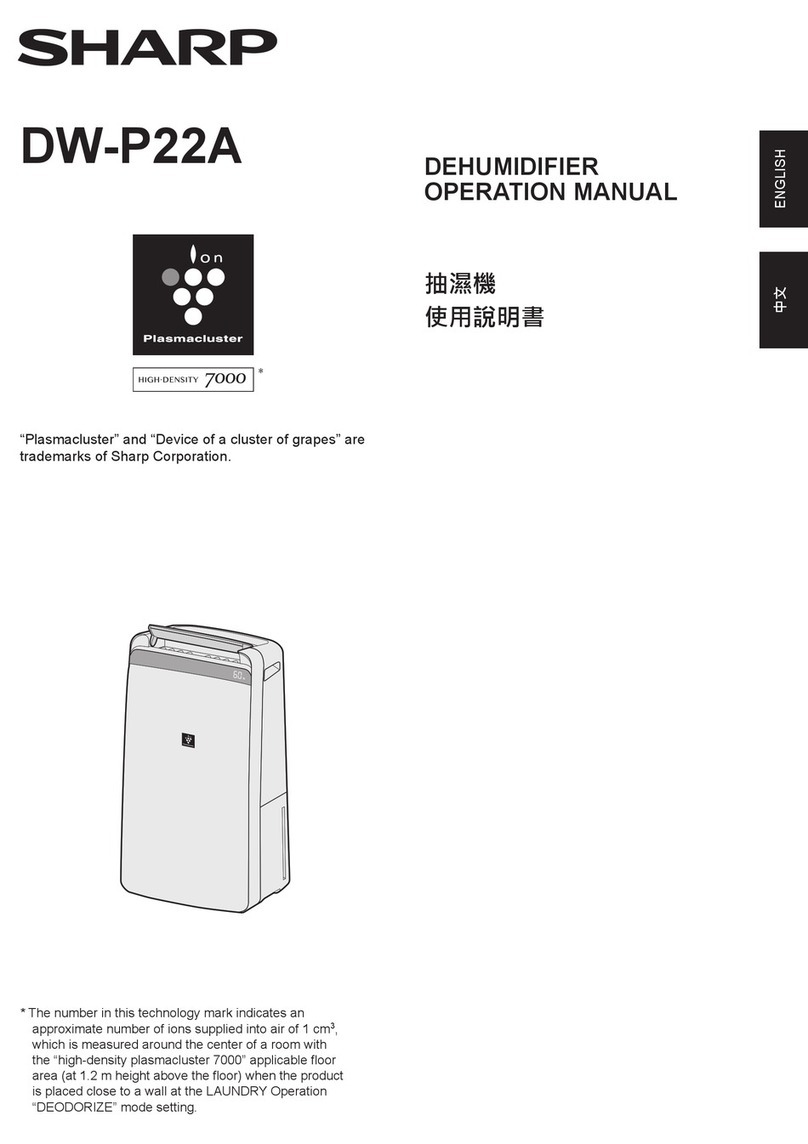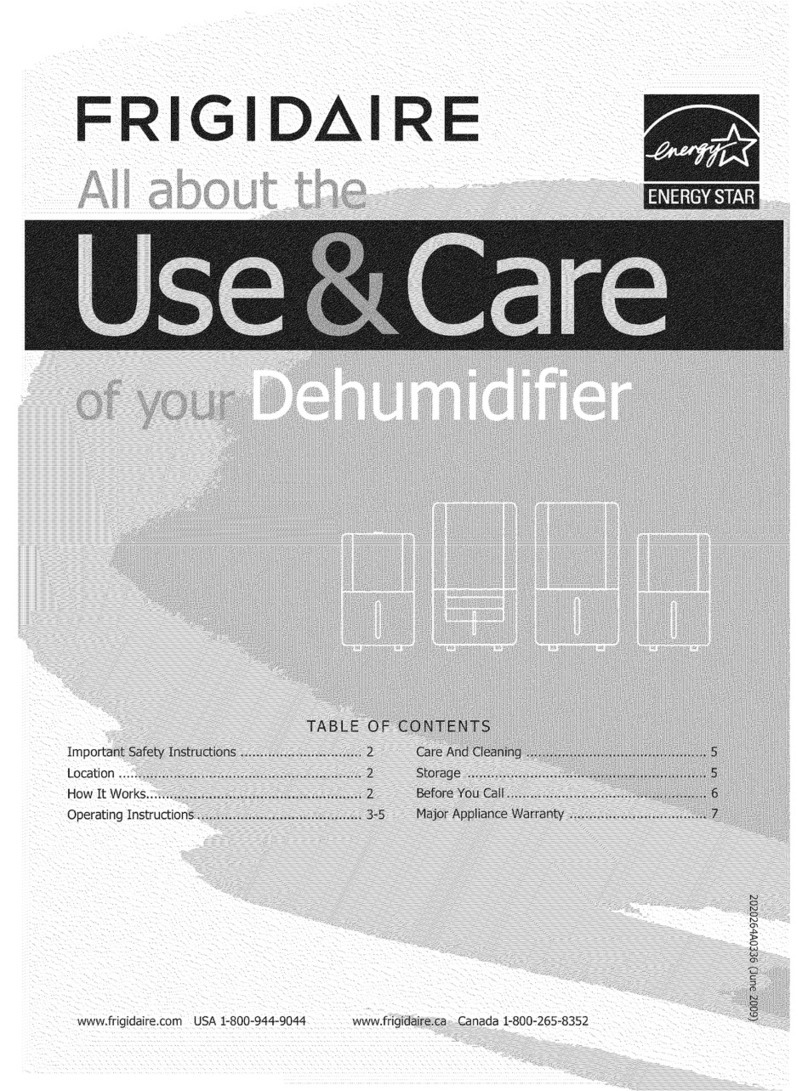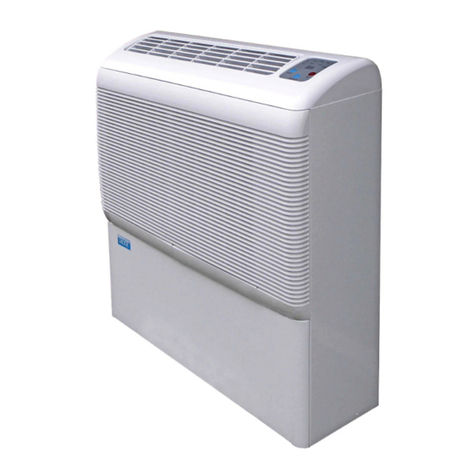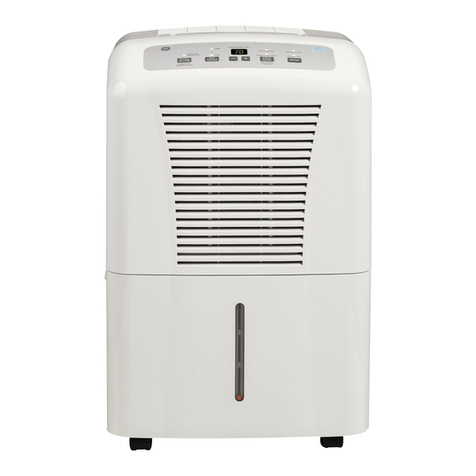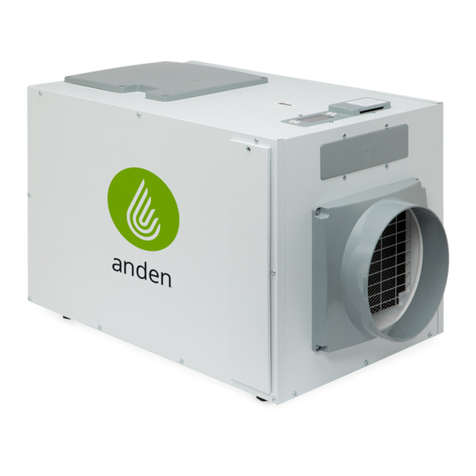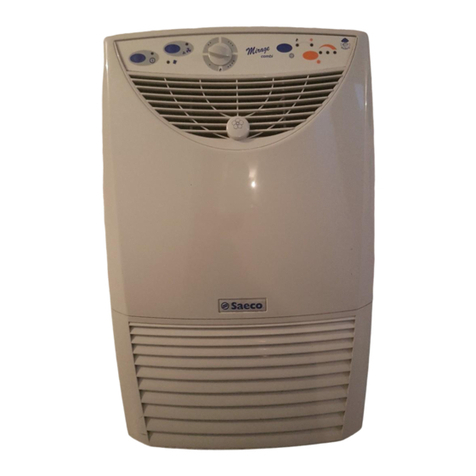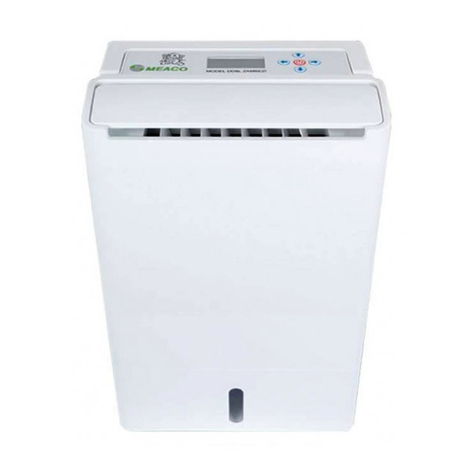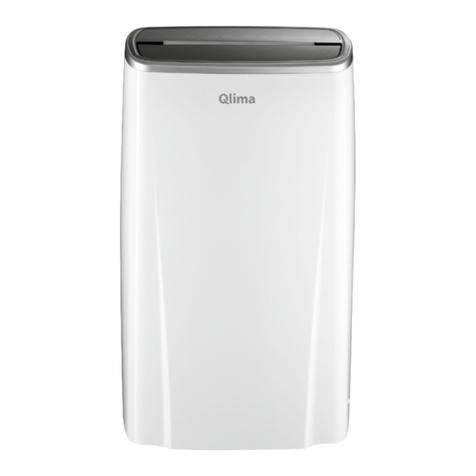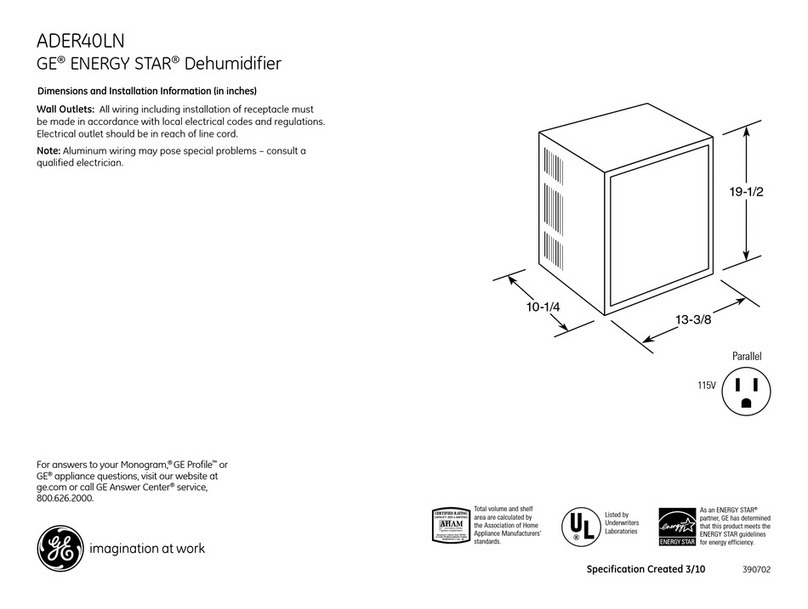Sullair SD Series User manual

SD-820 / SD-1710
DDS OPTION
3V OPTION
LDP OPTION
SD Heatless Desiccant
Compressed Air Dryer
REF 02250130-737
SERIES SD

INSTALLATION, START-UP & MAINTENANCE MANUAL
MODEL NO.: SD-820 / SD-1710
REV 1 – AUGUST 03,.2001
Page 2
TABLE OF CONTENTS
FOREWORD................................................................................................................................. 4
SECTION 1 INTRODUCTION.................................................................................................... 5
1.1 GENERAL INFORMATION.............................................................................................. 5
1.2 SAFETY INSTRUCTIONS................................................................................................. 5
1.2.1 Identification of signs and symbols in this technical manual.............................................. 6
1.2.2 Safety tips for maintenance, inspection and assembly work............................................. 6
1.3 PERSONNEL QUALIFICATION ...................................................................................... 7
1.4 PRODUCT INFORMATION.............................................................................................. 8
1.4.1 Pressure vessel regulations............................................................................................. 8
1.4.2 Airtightness test............................................................................................................. 8
1.4.3 Overloading.................................................................................................................. 8
1.4.4 Technical data sheet...................................................................................................... 9
1.4.5 Transport.................................................................................................................... 10
1.4.6 Storage....................................................................................................................... 10
1.4.7 Use of a pre and after filter.......................................................................................... 10
SECTION 2 INSTALLATION................................................................................................... 11
2.1 SET-UP AND INSTALLATION....................................................................................... 11
SECTION 3 START UP AND OPERATION.......................................................................... 12
3.1 START UP/ SHUT DOWN ............................................................................................... 12
3.2 DESCRIPTION OF THE OPERATION ........................................................................... 12
3.2.1 Description of the operation......................................................................................... 13
3.2.2 Dryer operating sequence (No control or alarm option)................................................ 14
3.2.3 Operating sequence (DDS Option).............................................................................. 15
3.2.4 Alarms........................................................................................................................ 18
3.2.5 Electrical control......................................................................................................... 19
3.3 SPECIAL EQUIPMENT................................................................................................... 19
3.3.1 DDS Controls............................................................................................................. 19
3.3.2 DDS Controls – Start up and operation....................................................................... 20
SECTION 4 MAINTENANCE.................................................................................................. 22
4.1 REPLACEMENT OF THE DESICCANT......................................................................... 23
4.2 DISPOSAL OF THE DESICCANT.................................................................................. 23
4.3 CHANGING OF THE REGENERATION ORIFICE........................................................ 23
4.4 FILTERS............................................................................................................................ 24
4.4.1 General comments and use.......................................................................................... 24
4.4.2 Function...................................................................................................................... 24
4.4.3 Assembly and installation............................................................................................. 24
4.4.4 Maintenance ............................................................................................................... 24
4.4.5 Changing of filter elements........................................................................................... 25

INSTALLATION, START-UP & MAINTENANCE MANUAL
MODEL NO.: SD-820 / SD-1710
REV 1 – AUGUST 03,.2001
Page 3
4.4.6 Accessories ................................................................................................................ 25
SECTION 5 DRYER FLOW CAPACITY AND PURGE ADJUSTMENT............................ 26
5.1 DRYER FLOW CAPACITY............................................................................................. 26
5.2 CORRECTION FACTOR FOR INLET TEMPERATURE................................................ 26
5.3 PURGE ADJUSTMENT.................................................................................................... 27
SECTION 6 SPARE PARTS LIST.......................................................................................... 28
6.1 SPARE PARTS LIST FOR SD820 – SD1710................................................................... 28
6.2 SERVICE BULLETIN ....................................................................................................... 33
SECTION 7 TROUBLE SHOOTING & FAULTS................................................................... 47
7.1 THE DEW POINT IS TOO HIGH..................................................................................... 47
7.2 THE ADSORPTION DRYER DOES NOT SWITCH OVER............................................ 48
7.3 BACK PRESSURE IS TOO HIGH DURING REGENERATION PHASE....................... 49
7.4 SHORT-TERM SHUT-DOWN......................................................................................... 49
7.5 SHUT-DOWN IN CASE OF A FAULT OR FOR MAINTENANCE.............................. 50
7.6 RE-STARTING................................................................................................................. 50
SECTION 8 ANNEX................................................................................................................... 1

INSTALLATION, START-UP & MAINTENANCE MANUAL
MODEL NO.: SD-820 / SD-1710
REV 1 – AUGUST 03,.2001
Page 4
FOREWORD
This technical manual of S
Su
ul
ll
la
ai
ir
r®®is an aid in getting to know the adsorption dryer better
and in utilising its possibilities for application in accordance with its intended use.
Furthermore, this manual contains important information for safe, proper and economic
operation.
All instructions must be followed as written in order to avoid danger and damages
which could cause downtime and premature wear and tear on the adsorption dryer.
In addition to the technical manual and the accident prevention regulations which are
valid and compulsory in the country and in the particular workplace where the
adsorption dryer is being used, the recognized special rules for safe and proper
working procedures are also to be heeded. The technical manual must always be within
reach wherever the adsorption dryer is being used.
Each person involved with the set-up, start-up, operation, maintenance and repair of
the adsorption dryer in the User Company must have first read and understood the
technical manual and especially the safety tips.

INSTALLATION, START-UP & MAINTENANCE MANUAL
MODEL NO.: SD-820 / SD-1710
REV 1 – AUGUST 03,.2001
Page 5
SECTION 1 INTRODUCTION
1.1 GENERAL INFORMATION
The adsorption dryer of the SD-820 – SD-1710 series is built according to the latest
technological developments and recognized safety rules. Its use however can endanger
life and limb of the user or of third parties, and can lead to considerable damage to the
adsorption dryer and other material assets if:
•it is operated by personnel not trained or instructed in its use,
•it is improperly used,
•it is improperly maintained or serviced.
This can result in the loss of all damage claims.
This adsorption dryer is designed for neutral media free of aggressive water, oil and
solid elements. S
Su
ul
ll
la
ai
ir
r®®accepts no liability for corrosion damage and malfunctions
caused by aggressive media.
Applications other than those mentioned in this manual must be agreed to by S
Su
ul
ll
la
ai
ir
r®®
and confirmed in writing.
In the interest of further development,
S
Su
ul
ll
la
ai
ir
r®®reserves the right to make changes at any
time, which, in keeping with the essential characteristics of the adsorption dryer
described here, may be necessary for increasing efficiency or for reasons relating to
safety or to normal business practice.
1.2 SAFETY INSTRUCTIONS
This technical manual contains basic tips, which must be followed during set-up,
operation and servicing. It is thus of utmost importance that it be read by the assembly
technician before installation and start-up as well as by the specialist / operator in
charge, and it must always be within reach at the place where the adsorption dryer is
being used.

INSTALLATION, START-UP & MAINTENANCE MANUAL
MODEL NO.: SD-820 / SD-1710
REV 1 – AUGUST 03,.2001
Page 6
SECTION 1
1.2.1 Identification of signs and symbols in this technical manual
The safety tips contained in this technical manual, whose disregard could endanger
people and machines, are indicated by a general danger sign and the additional
markings Danger!or Attention!
Danger! / Attention!
Safety sign in accordance with DIN 4844 - W9
Warning against electrical voltage!
Safety sign in accordance with DIN 4844 - W8
Safety tips printed directly on the adsorption dryer must be heeded at all times and
must be kept completely legible.
*Advices
This sign refers to a procedure or sequence of particular interest or
importance. All tips must be followed to ensure proper use of this adsorption
dryer.
•This dot refers to working or operational steps. The steps are to be carried out in
the order of their appearance from top to bottom.
•The sign of a hyphen marks enumerations.
1.2.2 Safety tips for maintenance, inspection and assembly work
The operator is to make sure that all maintenance, inspection and assembly work is
carried out by special personnel who are authorized and qualified, and who are
adequately informed through careful study of the technical manual. For this reason,
special attention should be paid to the following attention and danger sign:

INSTALLATION, START-UP & MAINTENANCE MANUAL
MODEL NO.: SD-820 / SD-1710
REV 1 – AUGUST 03,.2001
Page 7
SECTION 1
Attention!
−Never make structural changes to the adsorption
dryer!
−Only use original spare and accessory parts!
−Never weld on a pressure vessel or change it in any
way!
Carry out maintenance work only when the adsorption
dryer is switched off, is depressurized and
disconnected from the electric power supply.
*Advices
Refer to the desiccant material safety data sheet (MSDS) when installing or
disposing of desiccant.
Danger!
Wear protective goggles when working with the
desiccant!
*Advices for protection
−If desiccant comes into contact with the eyes, rinse eyes immediately with a lot of
clear water.
−If the desiccant is spilled, clean up without causing swirls of dust.
−In case of fire, there is no restriction on the use of fire extinguishing material; the
reaction with water and foam is defined as strong.
−A mask must be worn.
1.3 PERSONNEL QUALIFICATION
The personnel involved in operation, maintenance, inspection and assembly must have
the corresponding qualifications to do this work. Areas of responsibility and supervision
of the personnel must be precisely established by the operator. Should the personnel
not possess the necessary knowledge, then they must be trained and instructed. If need
be, this training may be carried out by the manufacturer / supplier at the request of the
operator of the adsorption dryer. Further, the operator is to make sure that the
personnel completely understand the contents of the technical manual.

INSTALLATION, START-UP & MAINTENANCE MANUAL
MODEL NO.: SD-820 / SD-1710
REV 1 – AUGUST 03,.2001
Page 8
SECTION 1
1.4 PRODUCT INFORMATION
The adsorption dryer is used for the purpose of drying compressed air and other gases
according to its respective design. As a "standard model" the adsorption dryer is
equipped with two desiccant vessels and a pre- and after-filter, and depending on
certain conditions at the outlet, provides pure, dry and oil-free compressed air or
gases.
1.4.1 Pressure vessel regulations
The pressure vessels are designed according to the standard technical requirements.
They fulfill the test of the certifying procedure and carry the“U”, “UM” ASME Symbol.
Range of application
Type SD-820 – SD-1710
Operating overpressure Max. 150 PSIG
Temperature Max.
Min.
500 °F
-20 °F
1.4.2 Airtightness test
All adsorption dryers are subjected to an airtightness test prior to shipment using
compressed air.
1.4.3 Overloading
Attention!
Protect the adsorption dryer from overloads!
The adsorption dryer can become overloaded, if:
−The flow capacity of the medium to be dried
increases,
−The temperature of the air at entry, and
correspondingly its humidity increases,
−The min. operating pressure is under cut,
−The pre-filtration and separation of impurities are not
sufficient.

INSTALLATION, START-UP & MAINTENANCE MANUAL
MODEL NO.: SD-820 / SD-1710
REV 1 – AUGUST 03,.2001
Page 9
SECTION 1
1.4.4 Technical data sheet
Type SD-820 SD-1050 SD-1200 SD-1450 SD-1710
Medium Air, free of aggressive elements
Connection FLG – 150# 3” 3” 3” 3” 4”
Flow capacity (1) (STD)
SCFM 820 1050 1200 1450 1710
Flow capacity (1) (LDP)
SCFM 574 735 840 1015 1197
Desiccant
Standard Input temp.: from 100°F and dew point (2) –40°C (-40°F)
Filled with: activated alumina
LDP Dryers Input temp.: from 100°F and dew point (2) –73°C (-100°F)
Filled with: activated alumina
Quantity of desiccant
Per vessel [Lbs.] 460 600 700 800 952
Filter size (MPH,MPR) 910 1315 1315 2120 2120
Control PLC Controller
Operating voltage
Standard 120 V / 60 Hz (AC)
Special voltage Consult factory
Drying time
Standard 5 min
LDP Dryers 2 min
(1) Flow capacity in SCFM at 100 PSIG according to DIN ISO 7183
(2) Pressure dew point
NOTE: Settings for DDS:
Standard dryers DDS Control (-41°C) High humidity (-36°C)
LDP Dryers DDS Control (-74°C) High humidity (-69°C)

INSTALLATION, START-UP & MAINTENANCE MANUAL
MODEL NO.: SD-820 / SD-1710
REV 1 – AUGUST 03,.2001
Page 10
SECTION 1
1.4.5 Transport
After the adsorption dryer has been delivered, it must be checked for damage that may
have occurred during transport. If necessary, the Transport company must be informed
to register the damage.
*Advices
For transport within the company, only the skid of the adsorption dryers
SD-820 – SD-1710 may be used.
1.4.6 Storage
If the adsorption dryer is to be stored for a longer period of time, its place of storage
must be dry and free of dust. There has to be a min. ambient temp. of +1°C (33°F).
1.4.7 Use of a pre and after filter
In order to prevent droplets of condensate, oil and dirt from getting into the desiccant,
a pre-filter is installed in front of the adsorption dryer, since an oil film on the desiccant
reduces the drying capacity and the dewpoint. In order to prevent breakdowns in
downstream consumers caused by material that has been abraded from the desiccant
bed, an after-filter is mounted behind the adsorption dryer. Since no condensate
accumulates in the after-filter, this filter is always equipped with a manual valve.
Both filters are equipped with a differential pressure gauge (standard) as this ensures
an indirect display of the degree of contamination of the filter elements.

INSTALLATION, START-UP & MAINTENANCE MANUAL
MODEL NO.: SD-820 / SD-1710
REV 1 – AUGUST 03,.2001
Page 11
SECTION 2 INSTALLATION
2.1 SET-UP AND INSTALLATION
Once at the installation location, the adsorption dryers of the series SD-820 – SD-
1710, which are supplied with a base frame, must be positioned so that the side from
which it is to be operated is easily accessible. The piping is to be connected to the
adsorption dryer at a light slope. A shut-off valve is to be installed on the inlet and outlet
sides of the adsorption dryer. Also, a by-pass pipe with an additional shut-off valve
should be mounted onto the adsorption dryer, in order to be able to guarantee an
uninterrupted supply of compressed air in case the adsorption dryer breaks down.
Should vibrations occur on the installation location, the adsorption dryer is to be placed
onto vibration dampers.
Since the adsorption dryer has already been completely wired at our factory, the
customer only has to connect the power supply cable to the terminal strip according to
the supplied wiring diagrams.
*Advice
Should you still have questions regarding installation, you can request
installation blueprints separately from S
Su
ul
ll
la
ai
ir
r®®MichiganCity,Indiana

INSTALLATION, START-UP & MAINTENANCE MANUAL
MODEL NO.: SD-820 / SD-1710
REV 1 – AUGUST 03,.2001
Page 12
SECTION 3 START UP AND OPERATION
3.1 START UP/ SHUT DOWN
Attention!
All pipes and wire connections are to be tightened!
Furthermore, before start-up:
−The pipes must be checked for the presence of scale,
abraded material from the threading, or other similar
impurities.
−All shut off valves on the pre-filter, adsorption dryer, after-
filter and on the bypass line should be closed.
−The ambient temperature must not be less than 33°F.
Breakdowns resulting from faulty installation do not fall under the S
Su
ul
ll
la
ai
ir
r®®warranty
obligation.
*Advices
The following sequence is to be heeded for the initial start-up:
•Slowly open the inlet valve and observe the pressure build-up on the
chamber pressure gauges of the adsorption dryer. A too abrupt pressure
build-up is to be avoided
•Turn the switch to the "POWER ON" position..
•The adsorption dryer must be powered approx. 3-4 h with the shut off valve
behind the after-filter closed; this regenerates the desiccant.
•After the regeneration phase, open the shut off valve behind the after-filter
slowly while observing the chamber pressure gauge; if the shut off valve is
opened too abruptly, it could put a stress on the system.
•The adsorption dryer is now ready for operation and functions continuously
and fully automatically.
3.2 DESCRIPTION OF THE OPERATION
The S
Su
ul
ll
la
ai
ir
r®®adsorption dryer of the series SD-820 – SD-1710 functions according to
the pressure change principle, using dry air regeneration. Two adsorption vessels filled
with desiccant are installed parallel to each other for this purpose. While the medium
is being dried in one vessel, regeneration takes place in the other vessel. The
changeover from one vessel to the other is performed in a fixed rhythm by means of a
time-dependent control system. The adsorption dryer operates continuously and fully
automatically.

INSTALLATION, START-UP & MAINTENANCE MANUAL
MODEL NO.: SD-820 / SD-1710
REV 1 – AUGUST 03,.2001
Page 13
SECTION 3
3.2.1 Description of the operation
SD HEATLESS TYPE DRYER (SD-820 – SD-1710)
•The S
Su
ul
ll
la
ai
ir
r®®SD dryer has a NEMA cycle time of 10 minutes (STD) or 4 minutes
(LDP) depending upon the air quality desired. In a 10 minute cycle, 5 minutes is
dedicated to drying for each chamber (5 minutes half cycle). In a 4 minutes cycle,
the half cycle is then 2 minutes.
•Through the inlet switching valve wet air enters either desiccant chamber at the inlet
(bottom) and is dried as it flows upward through the desiccant bed. Dry air exits
the dryer through the outlet check valve.
•At the outlet of each chamber, a portion of the dry air (purge air) is diverted to the
regenerating chamber. The dry air, at near atmospheric pressure, will remove
previously adsorbed moisture as it flows downward through the desiccant bed
exiting through the purge exhaust muffler.
•The purge air is controlled by a purge adjusting valve and purge orifices located
in the purge line. Purge pressure can be monitored on the purge pressure gauge.
Refer to section on purge adjustment for instructions on setting the purge rate.
•Near the end of each half cycle, the chamber being regenerated will be re-
pressurized. For this to occur, the exhaust valve of the chamber being regenerated
closes while purge air continues to flow. Re-pressurizing the regenerated chamber
to operating pressure before placing it into service minimizes fluidization of the
desiccant and helps prevent desiccant abrasion which causes desiccant dust to
prematurely block pilot and after-filter elements.
•Dryers operating at pressures greater than 120-125 PSIG or in an accelerated
NEMA cycle could be fitted with a re-pressurizing valve. This valve assists the
regenerated chamber to reach dryer operating pressure before chamber
switchover.
•Chamber switchover takes place when both towers are fully pressurized to
minimize desiccant movement.
When switchover is complete, the regenerated tower will be placed into service and the
exhausted tower will begin a depressurization/regeneration cycle.

INSTALLATION, START-UP & MAINTENANCE MANUAL
MODEL NO.: SD-820 / SD-1710
REV 1 – AUGUST 03,.2001
Page 14
SECTION 3
3.2.2 Dryer operating sequence (No control or alarm option)
The S
Su
ul
ll
la
ai
ir
r®®SD-820 –SD-1710 heatless air dryers use a PLC as its standard controller.
In the event of a power failure, the exhaust valves will close and the dryer will pressurize
both chambers. Since this control panel uses retentive programming the dryer will return
to the same step in the cycle the dryer was in before power was lost.
Energizing control panel : Power is turned ON – electrical circuit energized.
STEP 1 SELECT LEFT CHAMBER DRYING.
- De-energize solenoid EV-1R.
- Energize solenoid EV-1L.
- Inlet valve positioned for left chamber drying.
- When 3 seconds have passed, go to STEP 2
STEP 2 RIGHT CHAMBER DE-PRESSURIZATION.
- Keep energized EV-1L
- Energize EV-2R opening right chamber dump/exhaust valve.
- When regeneration time has passed, go to STEP 3
STEP 3 RIGHT CHAMBER REPRESSURIZATION.
- Keep energized EV-1L.
- De–energize EV-2R closing right chamber dump/exhaust valve.
- The repressurization timer begins a countdown of 45 seconds.
- Inlet valve remains in current position.
- When repressurization time has passed, go to STEP 4
STEP 4 RIGHT CHAMBER DRYING.
- De-energize solenoid EV-1L
- Energize solenoid EV-1R.
- Inlet valve positioned for right chamber drying.
- When 3 seconds have passed, go to STEP 5
STEP 5 LEFT CHAMBER DEPRESSURIZATION.
- Keep energized EV-1R
- Energize EV-2L, opening right chamber dump/exhaust valve.
- When regeneration time has passed, go to STEP 5

INSTALLATION, START-UP & MAINTENANCE MANUAL
MODEL NO.: SD-820 / SD-1710
REV 1 – AUGUST 03,.2001
Page 15
SECTION 3
3.2.2 Dryer operating sequence (No control or alarm option) – (Continued)
STEP 6 RIGHT CHAMBER REPRESSURIZATION.
- Keep energized EV-1R.
- De–energize EV-2L closing right chamber dump/exhaust valve.
- The repressurization timer begins a countdown of 45 seconds.
- Inlet valve remains in current position.
The dryer has completed 1 full cycle and will repeat steps 1 through 6 until power is
removed from the control panel.
3.2.3 Operating sequence (DDS Option)
The S
Su
ul
ll
la
ai
ir
r®®SD-820-DDS – SD-1710-DDS and all “LDP” heatless air dryers use a PLC
as its standard controller. In the event of a power failure, the exhaust valves will close
and dryer will pressurize both chambers. Since this control panel uses retentive
programming, the dryer will return to the same step in the cycle dryer was in before
power was lost. (See NOTE 2)
Energizing control panel: Power is turned ON – electrical circuit energized.
STEP 1 SELECT LEFT CHAMBER DRYING.
- De-energize solenoid EV-1R.
- Energize solenoid EV-1L.
- Inlet valve positioned for left chamber drying.
- When 3 seconds have passed, go to STEP 2
STEP 2 RIGHT CHAMBER DE-PRESSURIZATION.
- Keep energized EV-1L
If not in DDS mode:
- Energize EV-2R opening right chamber dump/exhaust valve.
If in DDS mode and dewpoint is better than hygrometer setpoint:
-EV-2R does not energize.
When regeneration time has passed, go to STEP 3
STEP 3 RIGHT CHAMBER REPRESSURIZATION.
- Keep energized EV-1L.
- De–energize EV-2R closing right chamber dump/exhaust valve.
- The repress timer begins a countdown of 45 seconds (See Note 1)
- Inlet valve remains in current position.
- When repressurization time has passed, go to STEP 4

INSTALLATION, START-UP & MAINTENANCE MANUAL
MODEL NO.: SD-820 / SD-1710
REV 1 – AUGUST 03,.2001
Page 16

INSTALLATION, START-UP & MAINTENANCE MANUAL
MODEL NO.: SD-820 / SD-1710
REV 1 – AUGUST 03,.2001
Page 17
SECTION 3
3.2.3 Operating sequence (DDS option) – (Continued)
STEP 4 RIGHT CHAMBER DRYING.
- De-energize solenoid EV-1L
- Energize solenoid EV-1R.
- Inlet valve positioned for right chamber drying.
- When 3 seconds have passed, go to STEP 5
STEP 5 LEFT CHAMBER DEPRESSURIZATION.
- Keep energized EV-1R
If not in DDS mode:
- Energize EV-2L opening right chamber dump/exhaust valve.
If in DDS mode and dewpoint is better than hygrometer setpoint:
- EV-2R does not energize.
When regeneration time has passed, go to STEP 6
STEP 6 LEFT CHAMBER REPRESSURIZATION.
- Keep energized EV-1R.
- De–energize EV-2L closing left chamber dump/exhaust valve.
- The repress timer begins a countdown of 45 seconds (See note 1)
- Inlet valve remains in current position.
NOTE 1:EV-3 and repress valves could be used if dryer operating at pressure
above 125 PSI (G) and / or dryer operating on a timing cycle other than
10 minute cycle. Refer to the specification sheet in this manual or to the
flow schematic supplied with the dryer.
NOTE 2:Ifpowerfailureoccurstothedryerorunitisturnedoff,bothexhaustvalves
will close. The inlet valve will remain in its position.
NOTE 3: The actual timer setting may differ from the previously noted sequence.
Example: A dryer requiring 30 seconds to re-pressurize the
regenerating chamber will have a regeneration time of 4 minutes and 30
seconds. The half cycle time will remain at 5 minutes and full cycle at 10
minutes.
NOTE 4: The regeneration and re-pressurization times should be adjusted by
S
Su
ul
ll
la
ai
ir
r®®trained personnel only. Changing the factory settings will result in
loss of dew point and/or failure to re-pressurize before changeover.

INSTALLATION, START-UP & MAINTENANCE MANUAL
MODEL NO.: SD-820 / SD-1710
REV 1 – AUGUST 03,.2001
Page 18
SECTION 3
3.2.4 Alarms
** If any alarms options are supplied with dryer then a PLC will control the timing of the
dryer.
COMMON ALARM RELAY
Common alarm relay comes with any optional alarm. If any one of the alarms are
activated, the common alarm relay will also be activated.
SWITCHING FAILURE ALARM (OPTIONAL, INCLUDED WITHDDS OPTION)
Two pressure switches, sensing desiccant chamber pressure, are provided. An alarm
will be activated if both chambers remain at full pressure when regeneration is
required. Furthermore, if pressure in both chambers remain below set pressure, after
depressurization an alarm will be activated.
NOTE:Dryers equipped with DDS and operating in the DDS mode do not
depressurize during the purge cycle (and do not purge) when an
acceptable dew point is maintained. During this condition the switching
failure alarm is cancelled.
The alarm has a 1-minute delay.
HIGH HUMIDITY ALARM (OPTIONAL, INCLUDED WITHDDS OPTION)
The hygrometer provided has been programmed to initiate an alarm if the dryer outlet
dew point falls below the setting. An alarm light is provided.
NOTE:The alarm has a 20-minute delay when the dryer is first powered up, then
the alarm is instant if the condition exists.
IF THE HYGROMETER BOARD TO PROBE CONNECTION FAILS,
then a fault will observed by the hygrometer. The high humidity alarm light will flash on
and off. The dryer will go into a fixed cycle mode. The digital display will indicate “OPN”.

INSTALLATION, START-UP & MAINTENANCE MANUAL
MODEL NO.: SD-820 / SD-1710
REV 1 – AUGUST 03,.2001
Page 19
SECTION 3
3.2.5 Electrical control
Danger!
Work on electrical installations may only be done by a
specialist or by other persons instructed in this type of
work as long as they are under the instruction and
supervision of a specialist; the general rules for working
with electricity must be followed!
You find the corresponding operating and control voltage on the data sheet.
The S
Su
ul
ll
la
ai
ir
r®®adsorption dryer of the SD series is normally operated with a PLC
controller. The set times are adjusted at the factoryduring the test run.
Do not change these adjustments!
3.3 SPECIAL EQUIPMENT
3.3.1 DDS Controls
The DDS control option is a Dewpoint Dependant Switching system that monitors the
dryer dewpoint performance and manages the requirement for regeneration of the
dryer. The DDS controls major components are a digital dewpoint display hygrometer
and a humidity sensor.
The S
Su
ul
ll
la
ai
ir
r®®type SD Air dryer is designed to provide a specific pressure dewpoint
performance (generally –40 F (-40 C)) at the most severe operating conditions
specified. (Maximum flow at lowest pressure and highest inlet temperature). The
regeneration purge flow rate required for the dryer is calculated and adjusted to achieve
this dewpoint and is based on these conditions.
For example, for dryers operating at 100 PSIG (690 kPa) and 100 F (38 C) the purge
flow rate is approximately 15% of the specified maximum inlet flow. Dryers operating
under less severe inlet conditions will introduce a reduced humidity load. The DDS
controls have been factory programmed to monitor the dryer outlet dewpoint
performance and prevent initiation of a regeneration cycle under these conditions.
The DDS controls system has the following standard features, refer to the enclosed
technical bulletin for a complete overview of the digital hygrometer display.
Digital display can be toggled to degrees F, C, and PPM.
Detection for cable fault between hygrometer and moisture probe.
Stainless steel humidity probe sampling cell with service valves.

INSTALLATION, START-UP & MAINTENANCE MANUAL
MODEL NO.: SD-820 / SD-1710
REV 1 – AUGUST 03,.2001
Page 20
SECTION 3
3.3.2 DDS Controls – Start up and operation
The DDS controls system when supplied should be disabled for the initial 8 hours of
dryer operation. A dryer fitted with the DDS control will have a 3-position selector switch
on the electrical control panel. The 3 positions of this switch will perform the following
actions:
Position 1: POWER OFF
Position 2: POWER ON
Position 3: DDS ON
The POWER ON position will allow the hygrometer to be energized yet force the dryer
to operate on a FIXED CYCLE mode. The dryerSHOULD BE OPERATED IN THIS
POSITION AT TIME OF INITIAL STARTUP AND AT ALL TIMES WHEN THE
HYGROMETER OR HUMIDITY PROBE ARE REMOVED FOR SERVICE OR
CALIBRATION.
The DDS ON position will control the dryer regeneration steps when the dewpoint of the
dryer is better than the factory adjusted setpoint programmed into the digital
hygrometer.
The startup procedure for the DDS system will be as follows. Refer to the assembly
drawing in the following section.
1. Verify that the sample line (1/8 Teflon tube) is connected from the dryer outlet (see
flow schematic enclosed) to the inlet valve on the humidity probe sample cell.
2. Verify that the humidity probe is installed into the sample cell
3. Connect the coaxial cable to the humidity probe
4. Fully open the inlet valve to the sample cell
5. Partially open the discharge valve of the sample cell to bleed off a small amount of
sample air. Do not fully open discharge valve
6. Perform a soap test to verify for leaks on all parts of the sample line connections and
the humidity sample cell.
7. The digital display will now read the dewpoint of the dryer system. It will take a short
period of time for a humidity probe to be purged of humidity.
Other manuals for SD Series
3
This manual suits for next models
5
Table of contents
Other Sullair Dehumidifier manuals

Sullair
Sullair SM1100 Installation and operating instructions
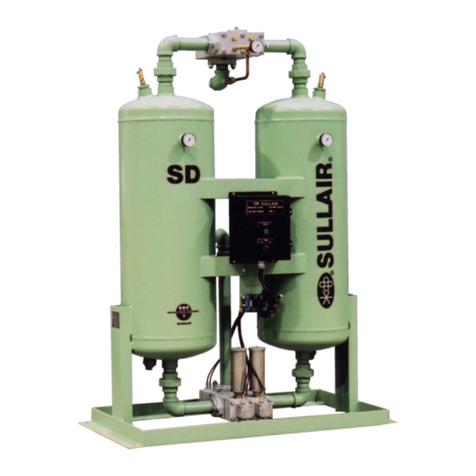
Sullair
Sullair SD Series User manual
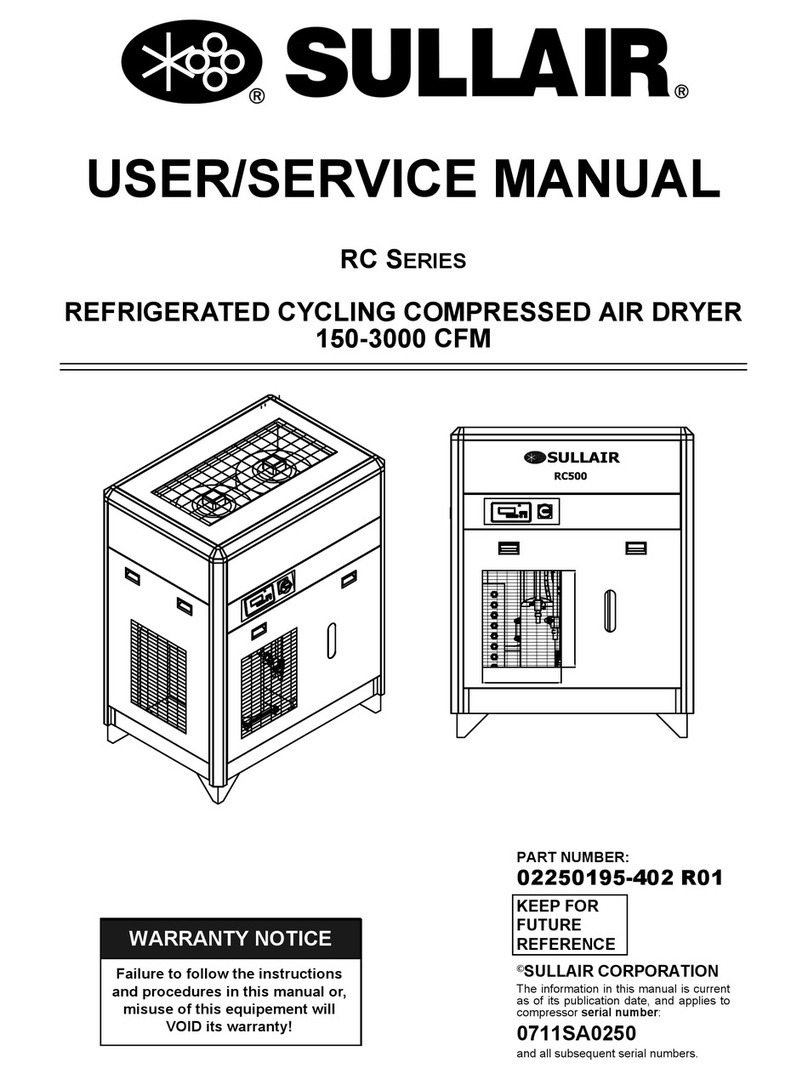
Sullair
Sullair RC Series Troubleshooting guide

Sullair
Sullair DBP Series Troubleshooting guide
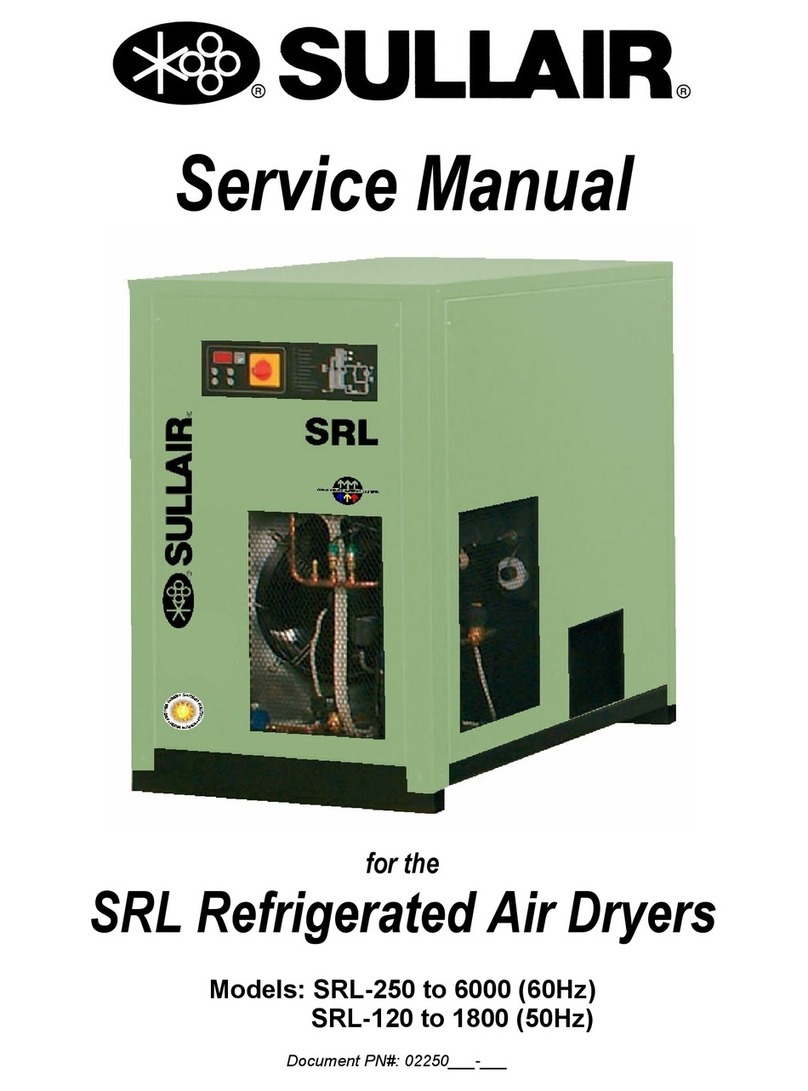
Sullair
Sullair SRL Series User manual

Sullair
Sullair SD Series User manual
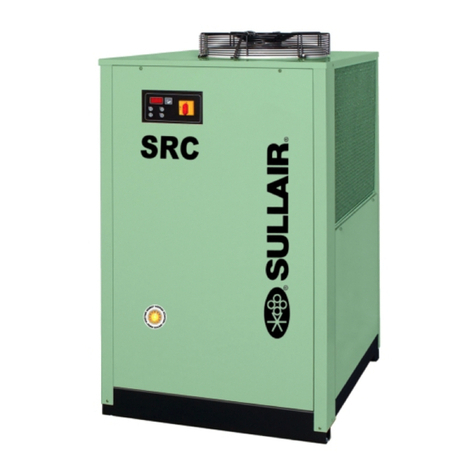
Sullair
Sullair SRC User manual
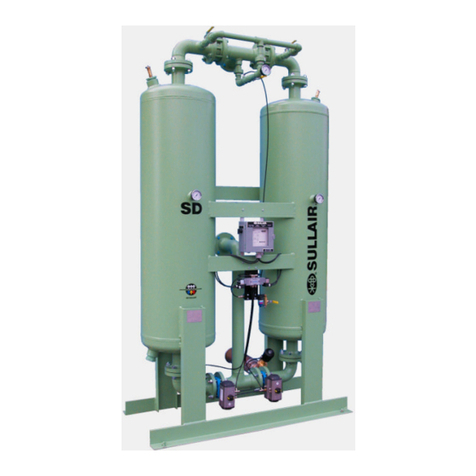
Sullair
Sullair SD-820 Series User manual
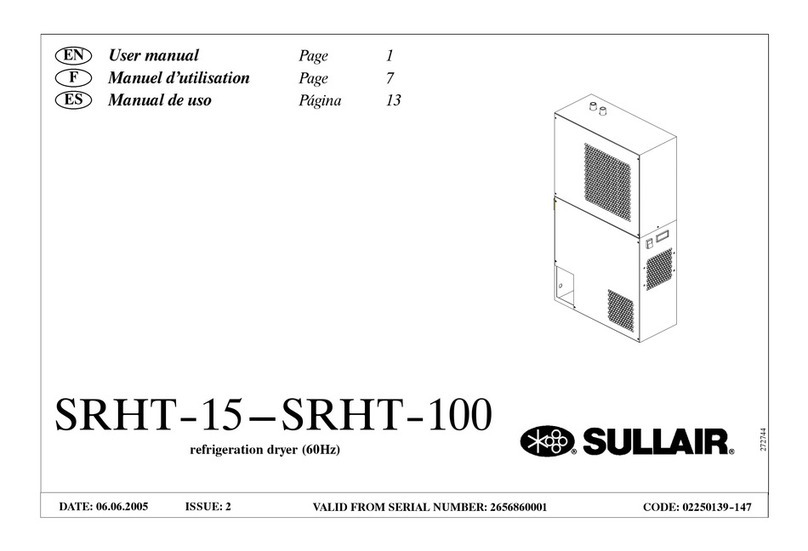
Sullair
Sullair SRHT-15 User manual
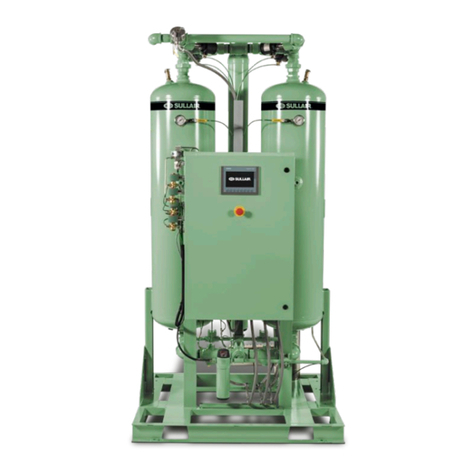
Sullair
Sullair DHL-80 Troubleshooting guide
